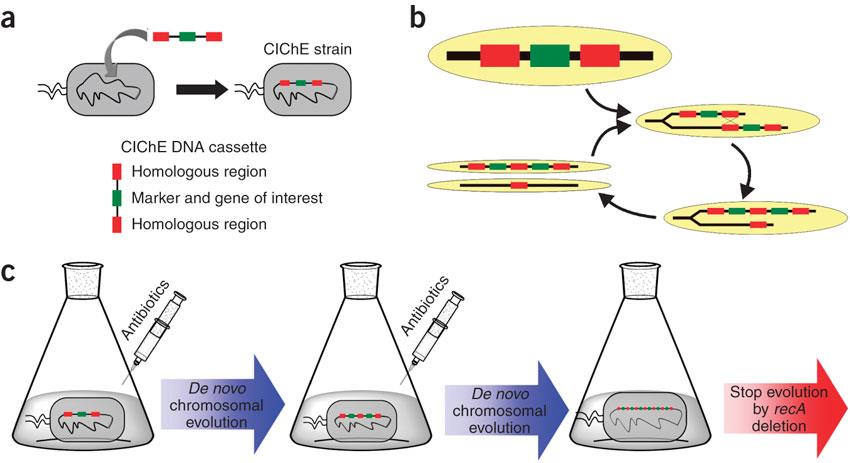Team:UGent/Project
From 2013.igem.org
(→Project Details) |
(→Introduction: high gene expression in industrial biotechnology) |
||
| Line 9: | Line 9: | ||
[[File:UGent_2013_CIChE.jpg|thumb|400px|center|Tyo et al., 2009]]This process is called chromosomal evolution. When the desired gene copy number is reached, recA is deleted, thereby fixing the copy number.{{:Team:UGent/Templates/ToggleBoxEnd}}To make this valuable technique more widely applicable in the industry, we developed a model for chromosomal evolution based on a toxin-antitoxin system instead of antibiotic resistance. | [[File:UGent_2013_CIChE.jpg|thumb|400px|center|Tyo et al., 2009]]This process is called chromosomal evolution. When the desired gene copy number is reached, recA is deleted, thereby fixing the copy number.{{:Team:UGent/Templates/ToggleBoxEnd}}To make this valuable technique more widely applicable in the industry, we developed a model for chromosomal evolution based on a toxin-antitoxin system instead of antibiotic resistance. | ||
| - | + | == Our model == | |
Revision as of 11:14, 2 August 2013
Contents |
Introduction: high gene expression in industrial biotechnology
The main goal of industrial biotechnology is to increase the yield of biochemical products using microorganisms as production hosts. This includes engineering large synthetic pathways and improving their expression. Overexpression of genes has mainly been achieved by using high or medium copy plasmids. However, studies have demonstrated that plasmid-bearing cells lose their productivity fairly quickly as a result of genetic instability.
In industrial biotechnology, a common technique to express new synthetic products and pathways is the use of plasmids as vectors. Plasmids are easy to insert into cells and replicate independently from the genome, allowing strong gene expression. Overexpression is easily achieved by using plasmids with a medium or high copy number, different promoter systems, ribosome binding sites (RBS), etc. Thanks to plasmids, the industrial biotechnology has grown substantially over the past years. However, the use of plasmids entails some important disadvantages.
CloseIn 2009, Tyo et al. developed a technique for the stable, high copy expression of a gene of interest in E. coli without the use of high copy number plasmids, thus avoiding their previously stated negative characteristics2. They called this plasmid-free, high gene copy expression system ‘chemically inducible chromosomal evolution’. In this method, the gene of interest is integrated in the microbial genome and then amplified to achieve multiple copies and reach the desired expression level. Genomic integration guarantees ordered inheritance, resolving the problem of allele segregation. CIChE works as follows: First a construct, containing the gene(s) of interest and the antibiotic marker chloramphenicol acetyl transferase (cat) flanked by homologous regions, is delivered to and subsequently integrated into the E. coli genome. The construct can be amplified in the genome through tandem gene duplication by recA homologous recombination. Then the strain is cultured in increasing concentrations of chloramphenicol, providing a growth advantage for cells with increased repeats of the construct and thereby selecting for bacteria with a higher gene copy number (Figure).
This process is called chromosomal evolution. When the desired gene copy number is reached, recA is deleted, thereby fixing the copy number.CloseOur model
The Experiments
Part 3
Results

Tweets van @iGEM_UGent
 "
"
